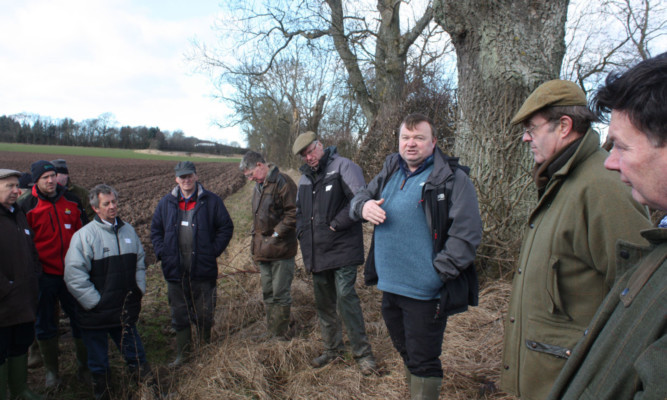The campaign to make greening simpler hit the fields at an NFU Scotland event at East Dron near Bridge of Earn.
An arable and livestock farm rising from 35ft above sea level on the heavy flatlands along the Baiglie straight, and rising to 500ft on the crest of the eastern Ochils, the unit is a microcosm of much of eastern Scotland and was ideal for demonstration purposes.
Around 80 attendees heard Rural Payments and Inspections Directorate (RPID) team leaders Alan Elder and Rod Renfrew explain what was acceptable and what was not when it came to creating the Environmental Focus Areas which are at the heart of the new CAP.
These EFAs should take up no less than 5% of the farm’s arable and temporary grass area if penalties are to be avoided.
It soon became apparent that if there were 80 farm businesses represented, there were 80 different questions and 80 different solutions.
Standing on a four-metre grass margin which the Sinclairs had created around one field, Mr Elder said he and the other 100 RPID staff members trained on greening issues would try to make life as simple as possible but there was a necessity to keep within the regulations.
Mr Renfrew advised constant reference to the guidelines. “I know measurements of features like this can be difficult, but you have to make the most accurate estimate possible.
“My advice would be to err on the cautious side. For example, if you have 100 hectares of arable don’t put in a neat five hectares of EFA. Make it 5.5 or even 6ha this first year.”
Mr Elder added that if he was making the decisions he would go for the fallow option. It was the simplest one and the easiest to measure accurately. This would allow field margins to be established this year ready for claiming in 2016.
One of the problems was that the EFA year runs from January 1 to December 31 leaving no opportunity for a cover such as grass to be established on these margins.
The position on ground classified as fallow was different as wild bird mixtures or wildflower mixtures could be sown during the fallow period which ends on July 15.
This raised questions about exactly what could take place on fallow, particularly regarding its use as potato headlands. It had been thought these could be used for turning machinery on, but it now appears this is not the case.
Constant turning on fallow headlands would not be good and there would be too great a temptation to use them as a dumping ground for stones from the separators.
Turning,it seemed, would only be allowed on an inner headland which could not be claimed as fallow.
Mr Elder did admit, however, that there would be no restrictions once the fallow period ended on July 15.
“My advice again is not to take risks, especially in year one and until the rules become clearer,” he said.
Moving on to a hedged field boundary (pictured) Mr Elder pointed to a feature that was quite common. Behind the hedge was a grassed-over and rarely used track and beyond that another hedge. There would be a temptation to claim this whole area as EFA, but that would be wrong, he stressed.
EFA areas had to be within field boundaries and the grass track and area beyond would appear as “white space” on farm maps and could not be claimed on.
Both Mr Elder and Mr Renfrew urged farmers to phone their local RPID offices with queries. They should not fear triggering inspections. In most cases the query could be answered quickly and simply in the office by the staff member looking at the farm’s aerial map.
NFU Scotland president Allan Bowie said: “We need to get this right and get recognition from the various bodies that we are making a difference. Otherwise there will be calls for a higher percentage of land to be used as EFAs.”
NFUS regional chairman Roddy Kennedy added: “The numbers here today show the level of concern within the industry. It also shows that even if we don’t welcome all the measures, we want to implement them correctly.”
